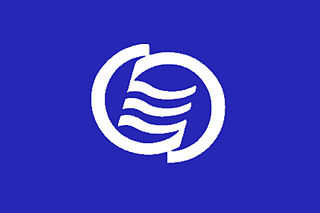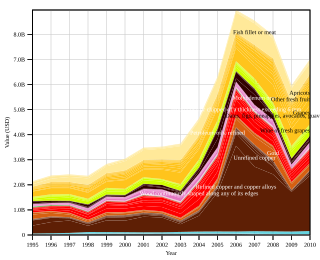
Asia-Pacific Economic Cooperation is an inter-governmental forum for 21 member economies in the Pacific Rim that promotes free trade throughout the Asia-Pacific region. Following the success of ASEAN's series of post-ministerial conferences launched in the mid-1980s, APEC started in 1989, in response to the growing interdependence of Asia-Pacific economies and the advent of regional trade blocs in other parts of the world; it aimed to establish new markets for agricultural products and raw materials beyond Europe. Headquartered in Singapore, APEC is recognized as one of the highest-level multilateral blocs and oldest forums in the Asia-Pacific region, and exerts significant global influence.

The Dominican Republic–Central America–United States Free Trade Agreement is a free trade agreement. Originally, the agreement encompassed the United States and the Central American countries of Costa Rica, El Salvador, Guatemala, Honduras, and Nicaragua, and was called CAFTA. In 2004, the Dominican Republic joined the negotiations, and the agreement was renamed CAFTA-DR.
The Canada–Central American Four Free Trade Agreement was a proposed free trade agreement between Canada and the Central American states of Guatemala, El Salvador, Honduras, and Nicaragua. Twelve rounds of negotiations were undertaken between 2001 and 2010, after which no agreement had been reached. Canada and Honduras instead decided to pursue a bilateral agreement between themselves, and those negotiations concluded successfully in August 2011.

The 2004 South American Summit – the third of its kind, after earlier events in Brasília and Guayaquil – was held in Cuzco and Ayacucho, Peru, on 7 –9 December 2004. Officially it constituted the Extraordinary Meeting of the Andean Presidential Council and was also billed as the Third Meeting of Presidents of South America.

The Association of Caribbean States is an advisory association of nations centered on the Caribbean Basin. It was formed with the aim of promoting consultation, cooperation, and concerted action among all the countries of the Caribbean coastal area. The primary purpose of the ACS is to promote greater trade between the nations, enhance transportation, develop sustainable tourism, and facilitate greater and more effective responses to local natural disasters.

The 4th Summit of the Americas was held at Mar del Plata, about 400 km (250 mi) southeast of Buenos Aires in Argentina, on November 4–5, 2005.

Historically speaking, bilateral relations between the various countries of Latin America and the United States of America have been multifaceted and complex, at times defined by strong regional cooperation and at others filled with economic and political tension and rivalry. Although relations between the U.S. government and most of Latin America were limited prior to the late 1800s, for most of the past century, the United States has unofficially regarded parts of Latin America as within its sphere of influence, and for much of the Cold War (1947–1991), actively vied with the Soviet Union for influence in the Western Hemisphere.

The United States is party to many free trade agreements (FTAs) worldwide.

The Central American Integration System has been the economic and political organization of Central American states since 1 February 1993. On 13 December 1991, the ODECA countries signed the Protocol of Tegucigalpa, extending earlier cooperation for regional peace, political freedom, democracy and economic development. SICA's General Secretariat is in El Salvador.

The Canada–Costa Rica Free Trade Agreement (CCRFTA) is a free trade agreement between Costa Rica and Canada. It was signed on April 23, 2001 in Ottawa, Ontario, and came into effect on November 1, 2002. It is the first bilateral free trade agreement to include innovative stand-alone procedures on trade. 87% of all tariffs on agricultural products were eliminated, either immediately, or over a 7-14 year period. Tariffs on many other industries like automotive goods and goods were also eliminated. Several sectors of agriculture were excluded from the treaty; eggs, dairy, poultry and beef being excluded, and Costa Rica decided to leave potatoes out of the FTA. Both nations agreed to use the World Trade Organization rules for sanitary and phytosanitary issues.
Colombia is a relatively open, free market economy that is party to many free trade agreements (FTAs) worldwide. It has signed free trade agreements with many of its biggest trading partners including the United States and the European Union, and is a founding member of the Pacific Alliance regional trade bloc.
The integration of Latin America has a history going back to Spanish American and Brazilian independence, when there was discussion of creating a regional state or confederation of Latin American nations to protect the area's newly won autonomy. After several projects failed, the issue was not taken up again until the late 19th century, but now centered on the issue of international trade and with a sense of pan-Americanism, owing to the United States of America taking a leading role in the project. The idea of granting these organizations a primarily political purpose did not become prominent again until the post-World War II period, which saw both the start of the Cold War and a climate of international cooperation that led to the creation of institutions such as the United Nations. It would not be until the mid-20th century that uniquely Latin American organizations were created.

The United States-Chile Free Trade Agreement is a free trade agreement (FTA) between the United States and Chile signed on June 6, 2003. The pact came into force on January 1, 2004. On that date, tariffs on 90% of U.S. exports to Chile and 95% of Chilean exports to the United States were eliminated. The agreement also established that Chile and the U.S. will establish duty-free trade in all products within a maximum of 12 years (2016). In 2009, bilateral trade between the United States and Chile reached US$15.4 billion, a 141% increase over bilateral trade levels before the U.S.-Chile FTA took effect. In particular, U.S. exports to Chile in 2009 showed a 248% increase over pre-FTA levels.
Canadian mining in Latin America and the Caribbean began in the 20th century. Latin America and the Caribbean's vast resources give the region great geopolitical importance, attracting foreign interest for centuries. From the colonial race of European empires, to the multinationals of today's neoliberal capitalist world, this region continues to draw interest. Canada's involvement in Latin America increased dramatically since 1989 with several landmark negotiations and agreements. By 2009, the Canadian larger-company mineral exploration market in this region was valued at US$1.7 billion.

The free trade agreements of Canada represents Canada's cooperation in multinational trade pacts and plays a large role in the Canadian economy. Canada is regularly described as a trading nation, considering its total trade is worth more than two-thirds of its GDP. Of that total trade, roughly 75% is done with countries that are part of free trade agreements with Canada—primarily the United States through the Canada–United States–Mexico Agreement (CUSMA), and its predecessor the North American Free Trade Agreement (NAFTA). By the end of 2014, Canadas bilateral trade hit Can$1 trillion for the first time. Canada is a signatory to 15 free trade agreements with 51 different countries.

The Pacific Alliance is a Latin American trade bloc, formed by Chile, Colombia, Mexico and Peru, which all border the Pacific Ocean. The alliance was formed with the express purpose of improving regional integration and moving toward complete freedom in the movement of goods, services, capital and people between the four member states. Together, these four countries have a combined population of more than 230 million people and make up roughly 35 percent of Latin American GDP.

The economy of Central America is the eleventh-largest economy in Latin America, behind Brazil, Mexico, Argentina and Colombia. According to the World Bank, the nominal GDP of Central America reached 204 billion US dollar in 2010, as recovery from the crisis of 2009, where gross domestic product (GDP) suffered a decline to 3.8%. The major economic sectors are agriculture and tourism, although the industrial sector has shown strong growth, mainly in Panama.
This is a list of the Honduras national football team results from 1990 to 1999.
This article provides details of international football games played by the Mexico national football team from 2000 to 2019.













